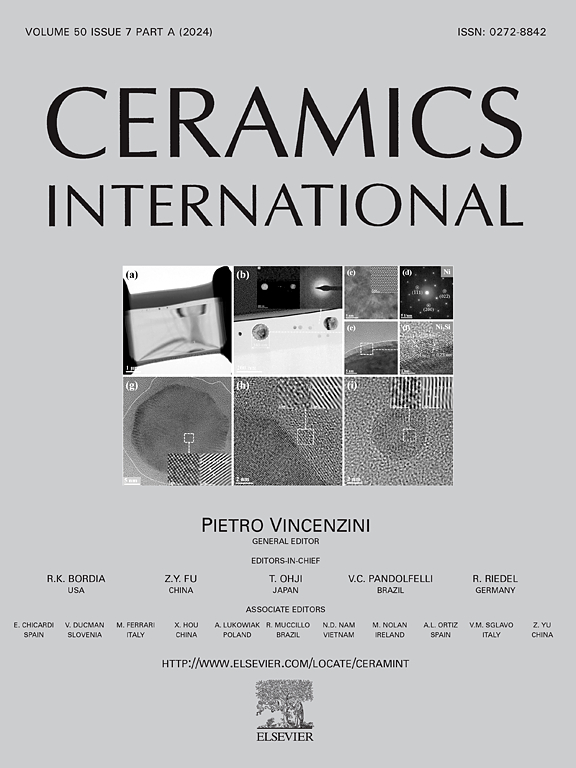在近零热猝灭和EQE为50.26%的条件下,实现了Cr3+掺杂无序石榴石的高能效宽带近红外发光
IF 5.1
2区 材料科学
Q1 MATERIALS SCIENCE, CERAMICS
引用次数: 0
摘要
对便携式近红外光源的需求日益增长,对开发高效、热稳定的近红外荧光粉提出了重大挑战。为了应对这一挑战,我们采用了阳离子替代策略。我们将铟(In)和镓(Ga)原子以1:1的M比掺入石榴石主体晶格的b位。通过在八面体位置放置In和Ga原子,诱导了有序-无序跃迁。该创新方法显著改善了荧光粉的性能特性。优化后的掺杂Cr3+的钆铟镓石榴石(GIGG)在770 nm处有发射峰,最大半峰宽为135 nm。其内部量子效率(IQE)达到96.17%,外部量子效率(EQE)达到50.26%。在423 K时,材料的发光强度保持在初始值的96.44%,表现出良好的热稳定性。这些特性使其成为光子器件中节能下转换层的理想候选材料。在后续研究中,利用优化后的GIGG:Cr3+制备的近红外磷转换发光二极管(pc-LED)在960 mA驱动电流下的近红外输出功率为241.04 mW,在30 mA时的光电转换效率(PCE)为15.25%,从而证明了其适用于各种光子应用。该研究提出了一种高效的宽带近红外石榴石基荧光粉,并为推进下一代,节能,紧凑的固态近红外光源提供了新的机会。本文章由计算机程序翻译,如有差异,请以英文原文为准。

Accessing energy-efficient broadband near-infrared luminescence in Cr3+-doped disordered garnet with near-zero thermal quenching and an EQE of 50.26 %
The ever-increasing demand for portable near-infrared (NIR) light sources has presented significant challenges in the development of highly efficient and thermally stable NIR phosphors. To address this challenge, we have employed a cation-substitution strategy. we incorporated indium (In) and gallium (Ga) atoms into the B-sites of the garnet-host lattice in a 1:1 M ratio. Through strategic placement of In and Ga atoms at octahedral sites, an order-disorder transition was induced. This innovative method has significantly improved the phosphor's performance characteristics. The optimized Cr3+-doped gadolinium indium gallium garnet (GIGG) exhibits an emission peak at 770 nm with a maximum full width at half-maximum (FWHM) value of 135 nm. Its internal quantum efficiency (IQE) reaches 96.17 %, while the external quantum efficiency (EQE) for this garnet-based material achieves 50.26 %. Furthermore, at 423 K, the material's luminescence intensity remains at 96.44 % of its initial value, demonstrating remarkable thermal stability. These characteristics render it an ideal candidate for energy-efficient down-conversion layers in photonic devices. In follow-up investigations, a NIR phosphor-converted light-emitting diode (pc-LED) fabricated using the optimized GIGG:Cr3+ delivered a NIR output power of 241.04 mW under 960 mA drive current and achieved a photoelectric conversion efficiency (PCE) of 15.25 % at 30 mA, thus demonstrating its suitability for various photonic applications. This study presents an efficient broadband NIR garnet-based phosphor and provides new opportunities for advancing next-generation, energy-efficient, and compact solid-state NIR light sources.
求助全文
通过发布文献求助,成功后即可免费获取论文全文。
去求助
来源期刊

Ceramics International
工程技术-材料科学:硅酸盐
CiteScore
9.40
自引率
15.40%
发文量
4558
审稿时长
25 days
期刊介绍:
Ceramics International covers the science of advanced ceramic materials. The journal encourages contributions that demonstrate how an understanding of the basic chemical and physical phenomena may direct materials design and stimulate ideas for new or improved processing techniques, in order to obtain materials with desired structural features and properties.
Ceramics International covers oxide and non-oxide ceramics, functional glasses, glass ceramics, amorphous inorganic non-metallic materials (and their combinations with metal and organic materials), in the form of particulates, dense or porous bodies, thin/thick films and laminated, graded and composite structures. Process related topics such as ceramic-ceramic joints or joining ceramics with dissimilar materials, as well as surface finishing and conditioning are also covered. Besides traditional processing techniques, manufacturing routes of interest include innovative procedures benefiting from externally applied stresses, electromagnetic fields and energetic beams, as well as top-down and self-assembly nanotechnology approaches. In addition, the journal welcomes submissions on bio-inspired and bio-enabled materials designs, experimentally validated multi scale modelling and simulation for materials design, and the use of the most advanced chemical and physical characterization techniques of structure, properties and behaviour.
Technologically relevant low-dimensional systems are a particular focus of Ceramics International. These include 0, 1 and 2-D nanomaterials (also covering CNTs, graphene and related materials, and diamond-like carbons), their nanocomposites, as well as nano-hybrids and hierarchical multifunctional nanostructures that might integrate molecular, biological and electronic components.
 求助内容:
求助内容: 应助结果提醒方式:
应助结果提醒方式:


